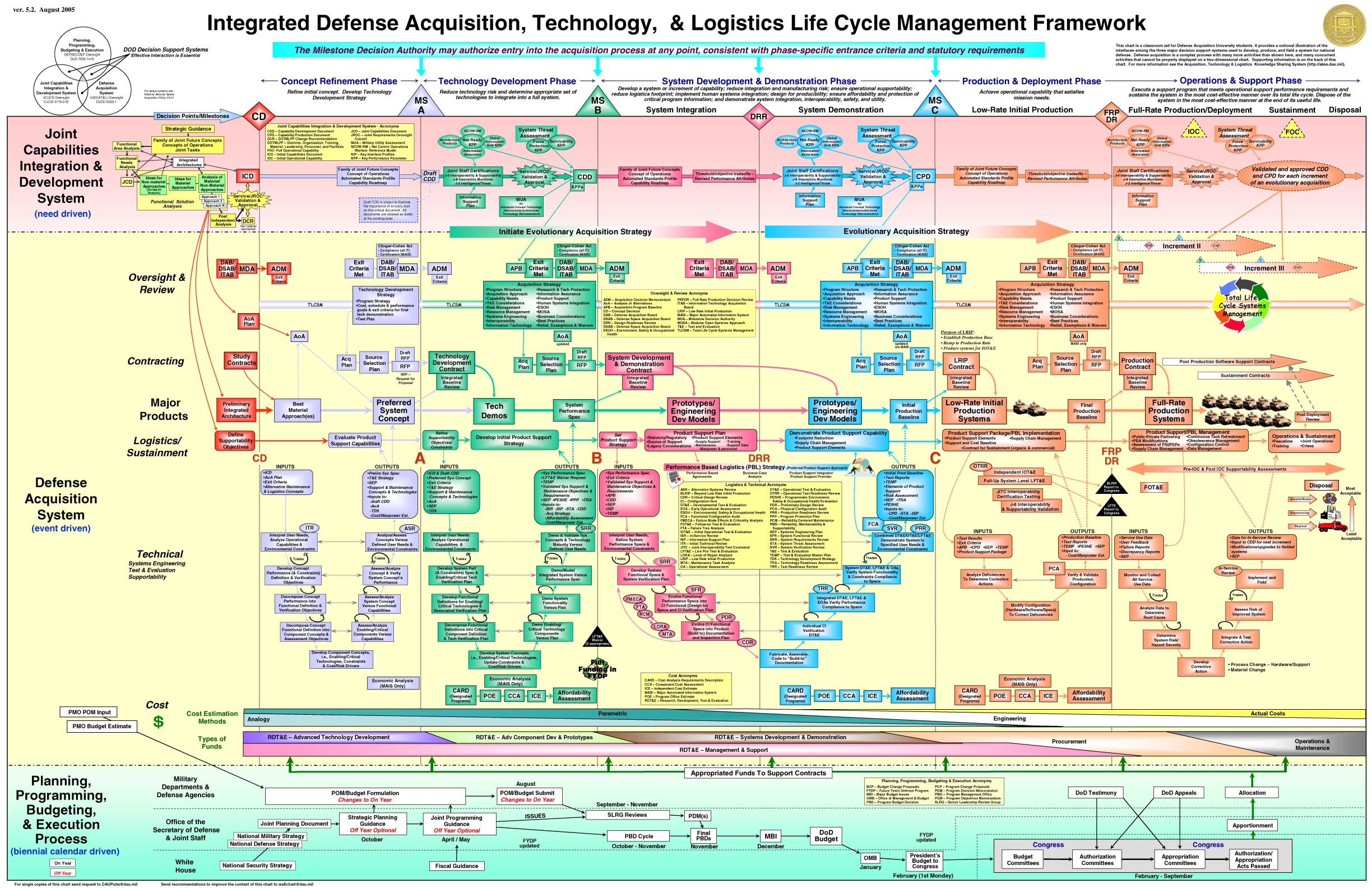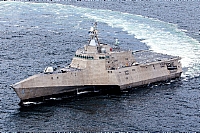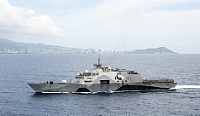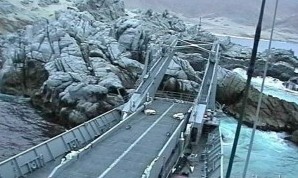
The DoD Process Simplified
I ran across an article from the National Defense Industrial Association (NDIA) the other day by Sandra Erwin on Congressional frustration on how the Pentagon buys things. Not being satisfied with the progress being made by the DoD Acquisition guru’s, Congress has decided that more legislation is needed to fix things (Really? Congress is going to fix something?). The Congress has asked nine of the industry associations around the Beltway to provide comments on how to make it better, with inputs due in July. I belong to several of those and I’m glad the Congress is asking for industry input, although I hope they remember that asking the people who make money as a result of inefficiencies is just one side of the argument. I think significant progress has been made since then Under Secretary of Defense for Acquisition, Technology and Acquisition (USD(AT&L)) Ash Carter launched his “Better Buying Power Initiative” in September of 2010. In his memo to acquisition professionals he provided a roadmap to improving acquisition within DoD. He focused on five areas of interest:
- Target Affordability and Control Cost Growth
- Incentivize Productivity and Innovation in Industry
- Promote Real Competition
- Improve Tradecraft in Services Acquisition
- Reduce Non-Productive Processes and Bureaucracy
Details of this can be found at this link if you are interested. All these are worthy goals, and they have made a difference. A recent GAO report found that some progress was being made, but that cost and schedule growth remain significant; 39 percent of fiscal 2012 programs have had unit cost growth of 25 percent or more. The amount of money in the DoD acquisition pipeline is staggering; 86 major defense acquisition programs estimated to cost a total of $1.6 trillion according to GAO. If you have any questions about a specific program click here.
Besides the modest, if not marginal, improvements in acquisitions, some not so nice things happened as well. As is often the case in large bureaucracies, what the big guys at the top are saying and what the little guys in the field are hearing frequently don’t jive. That was the case with the Better Buying Power Initiative.
Dr. Carter said “Increase the use of Fixed Price Incentive Fee contract type where appropriate…”, but the dudes in the field heard “More Fixed Price contracts, less Cost Plus Fixed Fee and Time and Materials contracts.” Contracting officers were suddenly burdened with having to provide extensive justification for any non-Fixed Price contract. Since they were busy enough, the Contracting Officers would rather just go with the flow and issue fixed price contracts, even though the work was not appropriate for them. The words “where appropriate” were overlooked. In the end, it wound up costing more money. Here’s why. When a contractor agrees to a fixed price contract, the contractor is assuming all of the risk. Suppose the job was improperly scoped by the Government, or suppose a software glitch pops up that takes time (and money) to fix. All those unexpected expenses are absorbed by the contractor. Consequently, Fixed Price contracts tend to be more expensive in order to cover the risk. This was certainly the case in my former life when a long-time client came to me and said, “The Boss says we have to do a Fixed Price contract” this year and it can only be for one year at a time. This was not what the customer wanted, but the customer was at the mercy of the acquisition folks. The work we were doing at the time was rather unpredictable and my team was never quite sure from day-to-day what they may be tasked with next. In order to be responsive, it was a Time and Materials (T&M) contract, which allowed us to flex to the client’s requirements. But with a fixed price contract, I was not able to flex without a contract modification (and that takes time and money). I told the client that if we were going to do a fixed price contract, I would have to increase the price and that I would not be as flexible in doing new work. That fell on deaf ears because it was going to be such a hassle to justify anything other than a fixed price contract.
Here’s another example. Dr. Carter says “Promote Real Competition”, but the folks in the field heard, “Use Lowest Price, Technically Acceptable (LPTA)” evaluation criteria for source selection.” This caused all kinds of price wars in the community and the Government was feeling smug about how much money they were saving, but…………Turns out many Requests for Proposals were poorly written with vague and overly broad technical requirements, so that just about any old company with the resources to put together a proposal could win the contract. And they bid ridiculously low rates, so in the end they were unable to deliver and customers began to fall back to other contact vehicles to get the work done, or just didn’t do the work. I think it’s a little too early to actually get to the real statistics about how many customers are really satisfied with the results of LPTA winning vendors but the Congress should find out before attempting to come up with more legislation.
The current USD(AT&L), Frank Kendall, issued an update to the original Better Buying Power, known around town as Better Buying Power 2.0. In it Mr. Kendall says:
- Achieve Affordable Programs
- Control Costs Throughout the Product Lifecycle
- Incentivize Productivity & Innovation in Industry and Government
- Eliminate Unproductive Processes and Bureaucracy
- Promote Effective Competition
- Improve Tradecraft in Acquisition of Services
- Improve the Professionalism of the Total Acquisition Workforce
The result has been a much greater focus on costs of acquiring the systems and a recognition that perhaps the LPTA pendulum was swinging just a little too far over. As in the original BBP, those in the field had some different interpretations about expectations from the top. One of the initiatives within the Incentivize Productivity goals was to “Align profitability more tightly with Department goals.” This translated into government auditors deciding they need to closely scrutinize contractors books to ensure vendor were not making “excessive profits,” even on fixed price work. I just don’t think that’s in the government’s lane. If they are so concerned about profit margins, then why not issue Cost Plus Fixed Fee contracts where the Government essentially controls corporate profits? Thus, despite all their good, it seems to me a few fundamental flaws in the acquisition system have not been addressed in BBP or BBP 2.0:
- There is still a lack of coordination and cooperation between those who generate requirements, those who pay to satisfy the requirements and those who buy the stuff with the money they are given.
- There is still a disconnect between contracting officers and the customers for whom they buy products and services.
- There is still a disconnect between what the leadership in the Pentagon says and what the people in the field do.
- The uncertainties of funding from year to year drive programs to their most expensive procurement options.
- Certain key programs get a “pass” from all the rhetoric about performance, affordability and life-cycle costs, overshadowing all of the progress made to reform acquisition. The top 10 acquisition programs still account for 65% of all the acquisitions according to the GAO. The Joint Strike Fighter is 25% of all DoD acquisition alone!
So in the end, I doubt very much if legislation will fix the problem. Four feet of stacked up Federal Acquisition Regulations and Defense Federal Acquisition Regulations are not going to be much affected by another thousand pages or so of legislation. Check out the recent testimony of Dr. Paul Francis, the Managing Director of Acquisitions and Sourcing Management at GAO. He has some very practical steps on how to improve the process. In addition to those steps, I would like to see DoD actually evaluate each program on its own merit, not on investment levels or political support or not simply press on with a poor program because they managed (mismanaged is probably the better word here) to get into a position where there is no alternative. It would also be nice if the people who are actually charged with executing the acquisition system at lower levels could have a say in how to make things better. There’s too much Top Down and not enough Bottom Up built into the process in my humble opinion. What if we asked the practitioners to come up with a series of reforms instead of the pontificators?


 Granted they do make a few hard choices, but none of them are the budget choices they are making for the FY15 budget that’s on the Hill right now. They have so much money to deal with that the normal ways in which you or I would deal with problems is not possible. There are several reasons why I believe the tough choices are not possible. In fact, in the Pentagon the toughest choices are actually the easiest. Take for example the luxury of scale. Because of the vast quantity of money the Pentagon has, scale makes things easy. Let’s just say for the sake of argument that the total Pentagon budget for 2015 will be around $550 Billion. I’m working on the budget and I need to come up with $5oo million to pay for my “widget ” program because it’s two years behind schedule and Congressional support is waning. I dare not go to the Hill and ask for more money. What tough choices can I make? How about I assume the inflation rate for next year will be 0.1% less than it currently is….Guess what? Instant $550 Million in my pocket. Problem solved!
Granted they do make a few hard choices, but none of them are the budget choices they are making for the FY15 budget that’s on the Hill right now. They have so much money to deal with that the normal ways in which you or I would deal with problems is not possible. There are several reasons why I believe the tough choices are not possible. In fact, in the Pentagon the toughest choices are actually the easiest. Take for example the luxury of scale. Because of the vast quantity of money the Pentagon has, scale makes things easy. Let’s just say for the sake of argument that the total Pentagon budget for 2015 will be around $550 Billion. I’m working on the budget and I need to come up with $5oo million to pay for my “widget ” program because it’s two years behind schedule and Congressional support is waning. I dare not go to the Hill and ask for more money. What tough choices can I make? How about I assume the inflation rate for next year will be 0.1% less than it currently is….Guess what? Instant $550 Million in my pocket. Problem solved!









